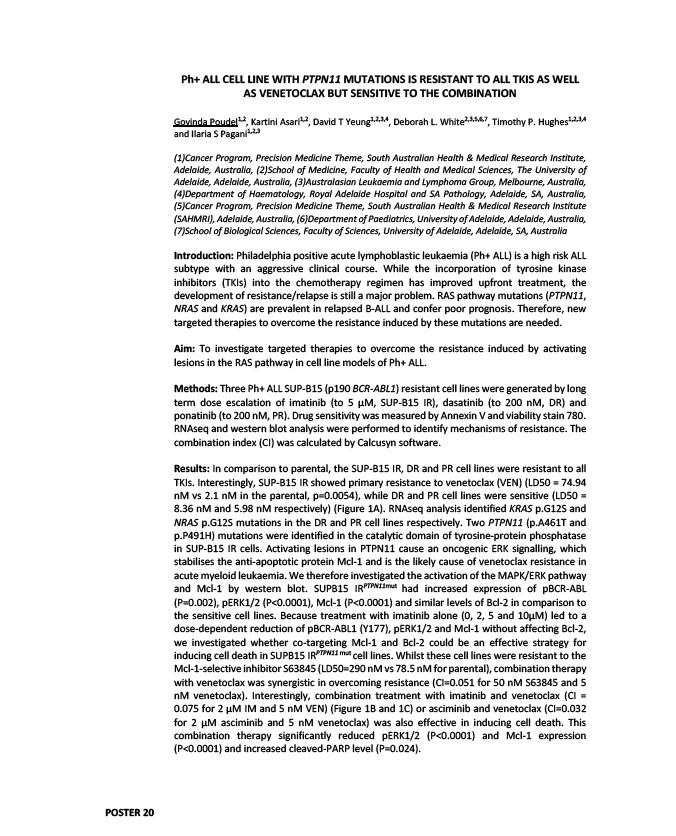
Ph+ ALL CELL LINE WITH PTPN11 MUTATIONS IS RESISTANT TO ALL TKIS AS WELL
AS VENETOCLAX BUT SENSITIVE TO THE COMBINATION
Govinda Poudel1,2, Kartini Asari1,2, David T Yeung1,2,3,4, Deborah L. White2,3,5,6,7, Timothy P. Hughes1,2,3,4
and Ilaria S Pagani1,2,3
(1)Cancer Program, Precision Medicine Theme, South Australian Health & Medical Research Institute,
Adelaide, Australia, (2)School of Medicine, Faculty of Health and Medical Sciences, The University of
Adelaide, Adelaide, Australia, (3)Australasian Leukaemia and Lymphoma Group, Melbourne, Australia,
(4)Department of Haematology, Royal Adelaide Hospital and SA Pathology, Adelaide, SA, Australia,
(5)Cancer Program, Precision Medicine Theme, South Australian Health & Medical Research Institute
(SAHMRI), Adelaide, Australia, (6)Department of Paediatrics, University of Adelaide, Adelaide, Australia,
(7)School of Biological Sciences, Faculty of Sciences, University of Adelaide, Adelaide, SA, Australia
Introduction: Philadelphia positive acute lymphoblastic leukaemia (Ph+ ALL) is a high risk ALL
subtype with an aggressive clinical course. While the incorporation of tyrosine kinase
inhibitors (TKIs) into the chemotherapy regimen has improved upfront treatment, the
development of resistance/relapse is still a major problem. RAS pathway mutations (PTPN11,
NRAS and KRAS) are prevalent in relapsed B-ALL and confer poor prognosis. Therefore, new
targeted therapies to overcome the resistance induced by these mutations are needed.
Aim: To investigate targeted therapies to overcome the resistance induced by activating
lesions in the RAS pathway in cell line models of Ph+ ALL.
Methods: Three Ph+ ALL SUP-B15 (p190 BCR-ABL1) resistant cell lines were generated by long
term dose escalation of imatinib (to 5 μM, SUP-B15 IR), dasatinib (to 200 nM, DR) and
ponatinib (to 200 nM, PR). Drug sensitivity was measured by Annexin V and viability stain 780.
RNAseq and western blot analysis were performed to identify mechanisms of resistance. The
combination index (CI) was calculated by Calcusyn software.
Results: In comparison to parental, the SUP-B15 IR, DR and PR cell lines were resistant to all
TKIs. Interestingly, SUP-B15 IR showed primary resistance to venetoclax (VEN) (LD50 = 74.94
nM vs 2.1 nM in the parental, p=0.0054), while DR and PR cell lines were sensitive (LD50 =
8.36 nM and 5.98 nM respectively) (Figure 1A). RNAseq analysis identified KRAS p.G12S and
NRAS p.G12S mutations in the DR and PR cell lines respectively. Two PTPN11 (p.A461T and
p.P491H) mutations were identified in the catalytic domain of tyrosine-protein phosphatase
in SUP-B15 IR cells. Activating lesions in PTPN11 cause an oncogenic ERK signalling, which
stabilises the anti-apoptotic protein Mcl-1 and is the likely cause of venetoclax resistance in
acute myeloid leukaemia. We therefore investigated the activation of the MAPK/ERK pathway
and Mcl-1 by western blot. SUPB15 IRPTPN11mut had increased expression of pBCR-ABL
(P=0.002), pERK1/2 (P<0.0001), Mcl-1 (P<0.0001) and similar levels of Bcl-2 in comparison to
the sensitive cell lines. Because treatment with imatinib alone (0, 2, 5 and 10μM) led to a
dose-dependent reduction of pBCR-ABL1 (Y177), pERK1/2 and Mcl-1 without affecting Bcl-2,
we investigated whether co-targeting Mcl-1 and Bcl-2 could be an effective strategy for
inducing cell death in SUPB15 IRPTPN11 mut cell lines. Whilst these cell lines were resistant to the
Mcl-1-selective inhibitor S63845 (LD50=290 nM vs 78.5 nM for parental), combination therapy
with venetoclax was synergistic in overcoming resistance (CI=0.051 for 50 nM S63845 and 5
nM venetoclax). Interestingly, combination treatment with imatinib and venetoclax (CI =
0.075 for 2 μM IM and 5 nM VEN) (Figure 1B and 1C) or asciminib and venetoclax (CI=0.032
for 2 μM asciminib and 5 nM venetoclax) was also effective in inducing cell death. This
combination therapy significantly reduced pERK1/2 (P<0.0001) and Mcl-1 expression
(P<0.0001) and increased cleaved-PARP level (P=0.024).
POSTER 20